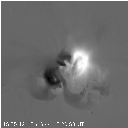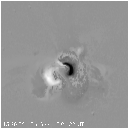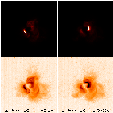Images of the X2 flare of May 2, 1998
Science nugget: July 04, 1998
General
The Yohkoh coverage for this event
was not so good, but at Barbara Thompson's request we have looked at the
SXT and found many interesting things. The SOHO data are great, she reports,
including the inevitable EIT wave and a remarkable halo
CME , which interestingly enough was concentrated in the north, despite
the S15 W15 flare location.
The image below shows a specially-scaled difference image from times
as indicated, showing the net effects of the flare on the active region.
These effects include the commonly-seen dimming regions and post-flare
loops. The scaling consists of separate square-root compressions for the
positive and negative differences.

Preflare situation
Several interesting things happened prior to the flare, and as usual it's
not proven that they are physically related, but... The image below shows
a difference (times indicated) prior to event onset (see the Yohkoh
coverage plot to orient the times.

Two curious bright arcs are visible, with their symmetry axes inclined
NW/SE and not pointing at Sun center, as any proper vertical loop should
do. These are therefore strongly tilted. Is this related to the strong
non-radial motion exhibited by the halo CME? One is dark, the other bright
in the difference image, but in fact both of these loop flares were prior.
The images below show these curious features better:

Here the upper row shows SXT images with a linear color table, and the
same images appear compressed and reverse-colored at the bottom. These
images have a lot of contrast!
Finally, the registered images below relate the preflare arc to the
flare brightenings, seen (faint) in an image prior to flare-mode trigger,
and (bright) after the trigger. The compact brightenings are no doubt hard
X-ray footpoints, but that's a separate analysis project! In any case we
see again that pre-flare phenomena do not seem to occur in the flare structure
itself, but in a nearby related structure. See for example Farnik et al.,
Solar Physics 165, 169, 1996.

Eruption
I am spending too much time on this nugget, but it is so interesting...
Here is the eruption movie from the
thick Al high-resolution images (2.5' FOV). Repeated looks will convince
you that this event has a linear ejective feature moving (roughly perpendicular
to its length) approximately NNE, again matching the location of the halo
CME . Such a linear bar feature is often seen in filament-eruption
events (see the Oslo Master's thesis of F. Solberg), especially (I think)
when Type II radio bursts are involved. Again, this linear feature was
obviously moving non-radially away from the flare site. There is also a
highly-collimated jet feature extending to the ENE, which exhibits a rather
obvious flow along its length (not seen in this movie though). I have no
time to research any of these things, but... Thanks, Barbara, for pointing
this out, and thanks, George Simnett, for coincidentally showing me the
halo CME .!
What does it all mean?
I'd like to think that this is more material with which we can try to understand
what I think of as early non-radial motions in CMEs. No doubt the X2 flare
"caused" this CME, or vice-versa for those people who prefer to
think backwards about these things, and no doubt the CME's motion was essentially
radial further out, but at the base of the corona it sure didn't look radial.
H. Hudson (hudson@isass0.solar.isas.ac.jp)




